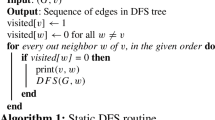Abstract
In this paper we present a fast parallel algorithm for constructing a depth first search tree for an undirected graph. The algorithm is anRNC algorithm, meaning that it is a probabilistic algorithm that runs in polylog time using a polynomial number of processors on aP-RAM. The run time of the algorithm isO(T MM(n) log3 n), and the number of processors used isP MM (n) whereT MM(n) andP MM(n) are the time and number of processors needed to find a minimum weight perfect matching on ann vertex graph with maximum edge weightn.
Similar content being viewed by others
References
R. J. Anderson, A parallel algorithm for the maximal path problem,Combinatorica,7 (1987), 315–326.
R. J.Anderson, A parallel algorithm for depth-first search,Extended Abstract, Math. Science Research Institute (1986).
R. J.Anderson and E.Mayr, Parallelism and greedy algorithms,Technical Report No. STAN-CS-84-1003,Computer Science Department, Stanford University (1984).
S. A. Cook, A taxonomy of problems with fast parallel algorithms,Information and Control,64 (1985), 2–22.
D.Eckstein and D.Alton, Parallel graph processing using depth first search,Proc. of the Conf. on Theoretical Computer Science at the Univ. of Waterloo, (1977), 21–29.
S. Even andR. E. Tarjan, Network flow and testing graph connectivity,SIAM Journal of Computing,4 (1975), 507–518.
R. K. Ghosh andG. P. Bhattacharjee, A parallel search algorithm for directed acyclic graphs,BIT,24 (1984), 134–150.
R. M. Karp, E. Upfal andA. Wigderson, Constructing a maximum matching is in randomNC, Combinatorica,6 (1986), 35–48.
R. M. Karp andA. Wigderson, A fast parallel algorithm for the maximal independent set problem,Journal of ACM,32 (1985), 762–773.
R. J. Lipton andR. E. Tarjan, A separator theorem for planar graphs,SIAM Journal of Applied Math. 36 (1979), 177–189.
K. Mulmuley, U. V. Vazirani andV. V. Vazirani, Matching is as easy as matrix inversion,Combinatorica 7 (1986), 105–114.
V.Ramachandran,Personal Communication.
E. Reghbati andD. Corneil, Parallel computations in graph theory,SIAM Journal of Computing,7 (1978), 230–237.
J. H. Reif, Depth-first search is inherently sequential,Information Processing Letters,20 (1985), 229–234.
J. R. Smith, Parallel algorithms for depth first searches,SIAM Journal of Computing,15 (1986), 814–830.
R. E. Tarjan, Depth-first search and linear graph algorithms,SIAM J. of Computing,1 (1972), 146–160.
J. C.Wyllie,The Complexity of Parallel Computations, Phd. Thesis, Department of Computer Science, Cornell University, 1979.
Author information
Authors and Affiliations
Additional information
This research was done while the first author was visiting the Mathematical Research Institute in Berkeley. Research supported in part by NSF grant 8120790.
Supported by Air Force Grant AFOSR-85-0203A.




